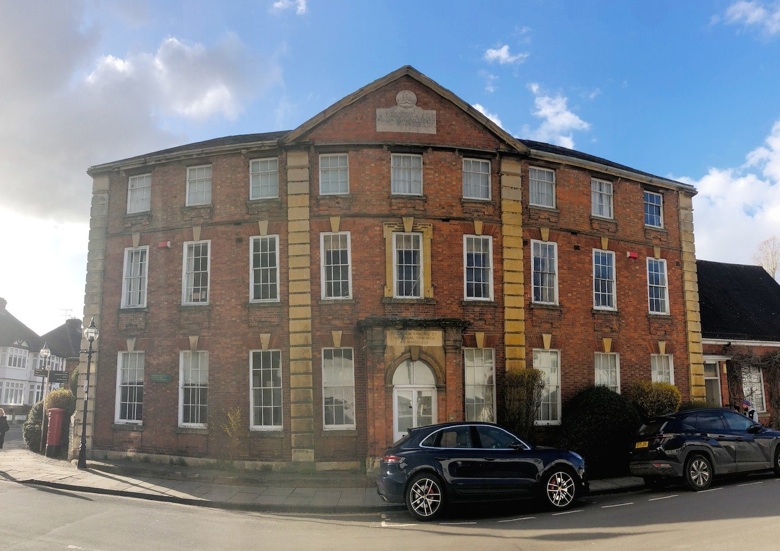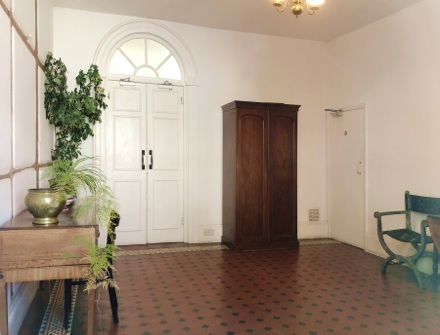Apartments

SLHS: Trinity College



Disclaimer
Whilst some care has been taken to check externally linked websites no responsibility is offered nor implied for the suitability, legality or reliability of content therein.
Statements are made here to the best of our knowledge. However no statement here should be regarded as irrefutable fact. Please contact us if you consider otherwise.
History
Back in 2013 the Focus section of the Stratford Herald newspaper expanded an article written by Bob Bearman on the history of this magnificent building. This is an adaptation of that expansion..
Barrister Rawlins
From around 1620 Edmund Rawlins, originally from Long Marston, had practiced as a lawyer in Stratford. In 1622 he had a son Thomas. He rose to be a “Serjeant-at-Law” or top-flight barrister. At some point the family acquired a large house on the site of the present one -they were certainly living there by the 1660s.
In 1697 Thomas's only son died childless. Thus two years later the house was passed to his nephew, another Thomas then aged ten, with instructions that he be brought up to study law.
In 1729 Thomas junior died unmarried. His affairs were found to be In such a sorry state that his property had to be sold to pay off mortgage debts.
It is unknown who built this magnificent family home. Either Thomas the elder before he died or his great-nephew, Thomas the younger, soon after 1710 when he would have come Into his Inheritance? On stylistic grounds the later date seems more likely. This would also explain Thomas junior's financial difficulties.
William Makepeace
In 1738 Rawlins' executors sold the house to William Makepeace of Hall's Croft who let it out to a wealthy mercer Philip Hatton followed by Hatton's son-in-law Thomas Mortlboys 'esquire'.”
John Bree
In the period 1780-1823 “it was the home of Doctor John Bree.
John Branston Freer
Next it was the turn of a gentleman, John Branston Freer, whose family had seen better times and who made things worse by speculating in the attempt to develop Victoria Spa at Bishopton. In 1871 he was forced to sell up.
Further Information..
Chapel Street
● These items have aspects that uniquely contribute to national or world history.

To return to Master page click on ‘Schools’ above.
-
● Full
-
● Partial
-
● None
-
Theatres ●


John Day Collis
The buyer was John Day Collis, the retired Headmaster of Bromsgrove School and from 1867 he became Vicar of the Holy Trinity Church. He had the grand idea of setting up a school there 'for about twelve boys, sons of clergymen and others, with really good voices'. who would be trained to sing in the choir.
This he did and renamed the building Trinity College. Things may have been helped along by his marriage In 1871 to Elizabeth Curry of Shottery Hall and widow of the wealthy Rear Admiral Douglas Curry.
In 1872 he added an extra storey to the top of the building (the change in brickwork and lack of window keystones are clearly visible). He also incorporated the symbol of the Trinity into the pediment. He replaced the original handsome doorway with a not very appealing porch inscribed with the date of foundation 1872. The plaque in the pediment, giving the foundation date as 1870, was a later addition. The school opened with six pupils which rise to 22 by the end of the month and to 152 by 1876. This high number was accommodated in a new block-like extension to the rear. This has since been demolished.
In 1877 the College was said to have the status of a 'quasi-public school'. However, it lacked an endowment and following Collis's death, in 1879, its ethos changed, developing into a virtual training school for the Civil Service and then a 'crammer’ for those planning an officer-career in the Army.
It closed in 1908.
Marie Covent
The freehold was then acquired by Marie Covent who lived next door at Masons Croft. It was then leased to the Boys Grammar School which was in need of more room for an increasing number of boarders.
Dr Donald Murray’s Surgery
This lease was surrendered in 1931 and, after a few years, the property passed to Dr Donald Murray and became the headquarters of a medical practice.


Apartments
In 1970s it was bought by a developer who converted the upper floors to apartments. The ground floor has a number of meeting rooms and a rudimentary kitchen. Occasionally events are held here.
Downstairs interior
Stone pediment plaque
Rev John Day Collis
Private House
Trinity College
Last update: 31/10/2024
Created: 11/03/2024
